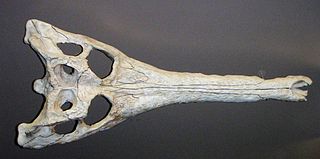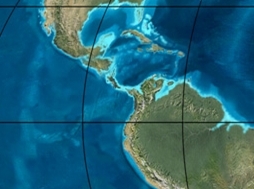
Gavialosuchus is an extinct genus of gavialid crocodylian from the early Miocene of Europe. Currently only one species is recognized, as a few other species of Gavialosuchus have since been reclassified to other genera.
Argochampsa is an extinct genus of eusuchian crocodylomorph, usually regarded as a gavialoid crocodilian, related to modern gharials. It lived in the Paleocene of Morocco. Described by Hua and Jouve in 2004, the type species is A. krebsi, with the species named for Bernard Krebs. Argochampsa had a long narrow snout, and appears to have been marine in habits.
Ocepesuchus is an extinct genus of gavialoid crocodilian, related to modern gharials. It lived in the Late Cretaceous of Morocco. Described by Jouve and colleagues in 2008, the type species is O. eoafricanus, with the specific name meaning "dawn African" in reference to its great age relative to other African crocodilians. Ocepesuchus had a long snout with a tubular shape, wider than high. It is the oldest known true crocodilian from Africa.

Harpacochampsa is a poorly known Early Miocene crocodilian from the Bullock Creek lagerstätte of the Northern Territory, Australia. The current specimen consists of a partial skull and fragments of a long, slender snout reminiscent of that of a false gharial, demonstrating that it was a piscivore in life.

Aktiogavialis is an extinct genus of crocodylian that lived from the Oligocene until the Miocene in what is now the Caribbean. Two species have been described: Aktiogavialis puertoricensis from the Middle Oligocene of Puerto Rico and Aktiogavialis caribesi from the Huayquerian of the Late Miocene of Venezuela.
Eogavialis is an extinct genus of eusuchian crocodylomorph, usually regarded as a gavialoid crocodylian. It superficially resembles Tomistoma schlegelii, the extant false gharial, and consequently material from the genus was originally referred to Tomistoma. Indeed, it was not until 1982 that the name Eogavialis was constructed after it was realised that the specimens were from a more basal form.
Eothoracosaurus is an extinct monospecific genus of eusuchian crocodylomorphs found in Eastern United States which existed during the Late Cretaceous period. Eothoracosaurus is considered to belong to an informally named clade called the "thoracosaurs", named after the closely related Thoracosaurus. Thoracosaurs in general were traditionally thought to be related to the modern false gharial, largely because the nasal bones contact the premaxillae, but phylogenetic work starting in the 1990s instead supported affinities within gavialoid exclusive of such forms. Even more recent phylogenetic studies suggest that thoracosaurs might instead be non-crocodilian eusuchians.

Gryposuchus is an extinct genus of gavialid crocodilian. Fossils have been found from Argentina, Colombia, Venezuela, Brazil and the Peruvian Amazon. The genus existed during the Miocene epoch. One recently described species, G. croizati, grew to an estimated length of 10 metres (33 ft). Gryposuchus is the type genus of the subfamily Gryposuchinae, although a 2018 study indicates that Gryposuchinae and Gryposuchus might be paraphyletic and rather an evolutionary grade towards the gharial.
Hesperogavialis is an extinct genus of gryposuchine gavialid. Fossils have been found from Venezuela and Brazil that date back to the Middle to Late Miocene. Although Hesperogavialis is one of the best known gavialoids from South America, the posterior portion of the skull is still unknown, making any attempts at classification within the family somewhat more difficult than other gavialoids in which much of the skull is present. The genus possibly comprises three species. The type species, H. cruxenti, has been found in the Urumaco Formation in Venezuela. A second possible species, named H. bocquentini, has been described from the Solimões Formation in Acre, Brazil, and can be distinguished from H. cruxenti by the asymmetry seen in the anterior portion of the nasals and the small distance between alveoli. A third species can be recognized from the same locality in Acre, although a formal name has yet to be given to it.
Ikanogavialis is an extinct genus of gavialid crocodilian. Fossils have been found in the Urumaco Formation in Urumaco, Venezuela and the Solimões Formation of Brazil. The strata from which remains are found are late Miocene in age, rather than Pliocene as was once thought. A possible member of this genus survived into the Late Holocene on Muyua or Woodlark Island in Papua New Guinea.

Kentisuchus is an extinct genus of gavialoid crocodylian, traditionally regarded as a member of the subfamily Tomistominae. Fossils have been found from England and France that date back to the early Eocene. The genus has also been recorded from Ukraine, but it unclear whether specimens from Ukraine are referable to Kentisuchus.
Paratomistoma is an extinct monospecific genus of gavialoid crocodylian. It is based on the holotype specimen CGM 42188, a partial posterior skull and lower jaw discovered at Wadi Hitan, Egypt, in Middle Eocene-age rocks of the Gehannam Formation. The skull is unfused but considered morphologically mature. Paratomistoma was named in 2000 by Christopher Brochu and Philip Gingerich; the type species is P. courti in honor of Nicholas Court, who found CGM 42188. They performed a phylogenetic analysis and found Paratomistoma to be a derived member of Tomistominae, related to the false gharial. It may have been a marine or coastal crocodilian.

The Castillo Formation is an Early Miocene geologic formation in the Falcón Basin of Venezuela. The formation unconformably overlies the Matatere, Misoa, El Paují and Jarillal Formations. The Castillo Formation is overlain by Quaternary alluvium and in places by the Capadare Formation. The formation, deposited in a calm near-shore lagoonal brackish environment, with possibly fluvial influence, has provided a rich assemblage of fossil crocodylians, turtles, giant sloths and various types of fish.

Piscogavialis is an extinct monospecific genus of gryposuchine gavialid crocodylian. The only species yet known is P. jugaliperforatus. Fossils of Piscogavialis have been found from the Mio-Pliocene Pisco Formation of the Sacaco Basin in southern Peru in 1998, where it coexisted with the much smaller gavialid Sacacosuchus.

Penghusuchus is an extinct genus of gavialid crocodylian. It is known from a skeleton found in Upper Miocene rocks of Penghu Island, off Taiwan. It may be related to two other fossil Asian gavialids: Maomingosuchus petrolica of southeastern China and Toyotamaphimeia machikanensis of Japan. The taxon was described in 2009 by Shan and colleagues; the type species is P. pani.

Thecachampsa is an extinct genus of gavialoid crocodylian, traditionally regarded as a member of the subfamily Tomistominae. Fossils have been found from the eastern United States in deposits of Miocene age. Those named in the 19th century were distinguished primarily by the shape of their teeth, and have since been combined with T. antiquus. More recently erected species were reassigned from other genera, although their assignment to Thecachampsa has since been questioned.
Gryposuchinae is an extinct subfamily of gavialid crocodylians. Gryposuchines lived mainly in the Miocene of South America. However, "Ikanogavialis" papuensis may have survived more recently, into the Late Pleistocene/Holocene. Most were long-snouted coastal forms. The group was named in 2007 and includes genera such as Gryposuchus and Aktiogavialis, although a 2018 study indicates that the group might be paraphyletic and rather an evolutionary grade towards the gharial.

Gavialoidea is one of three superfamilies of crocodylians, the other two being Alligatoroidea and Crocodyloidea. Although many extinct species are known, only the gharial Gavialis gangeticus and the false gharial Tomistoma schlegelii are alive today, with Hanyusuchus having become extinct in the last few centuries.
Globidentosuchus is an extinct genus of basal caimanine crocodylian known from the late Middle to Late Miocene of the Middle and the Upper Members of the Urumaco Formation at Urumaco, Venezuela. Its skull was very short and robust, with large units of spherical teeth used to break the shells of molluscs as part of its durophagus diet. It is thought to be one of the most basal Caimanines, even sharing some traits with alligatorids.
Sacacosuchus is an extinct monospecific genus of marine gavialid that lived along the coast of the south-east Pacific from approximately 19 to 6.3 million years ago. Its fossils have been found in the Chilcatay and Pisco Formations of Peru, where it coexisted with the much larger Piscogavialis. Based on its skull, Sacacosuchus was most likely a generalist feeder with an estimated total body length of 4.32 m (14.2 ft). Its extinction is thought to have been caused by a combination of factors including falling sea levels and global cooling.












